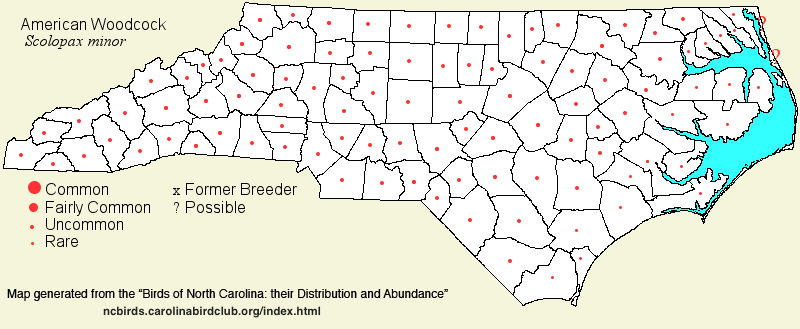 |  |
|
American Woodcock - Scolopax minor SCOLOPACIDAE Members: | Search Common: Search Scientific: |
|
|
|||||||
| General Comments | The American Woodcock is one of just two (with Killdeer the other) shorebird species that breeds over most parts of the state. Whereas about five other species nest on sand flats, bare ground, gravelly places, or marshes, the woodcock is the only one that nests in forests. It is a very early breeder, with eggs and/or young often seen in Mar. Woodcocks are perhaps best known to Carolina birders for the male's elaborate flight display, given at dusk and early evening in winter and early spring. The species spends the day resting in leafy cover of hardwood or mixed forests or taller thickets, especially where somewhat damp. At dusk, the birds leave the forest and fly out to nearby plowed fields and other muddy or short-grass habitats, where they feed on earthworms and other invertebrates in wet ground during the night; birds can be seen flying back from the fields into the forests at daybreak. Because of their secretive nature, being noted mainly at twilight, abundance levels are difficult to assign, and the breeding range is still poorly known in the lower Coastal Plain. In addition, global population trends over the decades are difficult to ascertain, though the general feeling is that populations in the Eastern States are in a decline. A remarkable and unprecedented (for NC) "fallout" of the species occurred in coastal Brunswick immediately after a winter storm in late Jan 2014. | ||||||
| Breeding Status | Breeder | ||||||
| NC BRC List | Definitive | ||||||
| State Status | |||||||
| U.S. Status | |||||||
| State Rank | S4B,S4N | ||||||
| Global Rank | G5 | ||||||
| Coastal Plain | Permanent resident, with migratory movements, over most of the province, though poorly known as a breeder near and along the coast. Along the coast, uncommon to locally fairly common in suitable forested habitat in migration and winter; poorly known as a breeder or in summer, but a number of such records, and thus apparently rare to uncommon. Status along the southern coast is uncertain as a breeder. In the Tidewater zone, fairly common in migration and winter, less numerous as a breeder, but probably uncommon and local. Farther inland, fairly common in migration and winter, and probably an uncommon breeder. On rare occasions, severely cold weather creates concentrations of birds along the immediate coast, even in yards, most recently in Jan-Feb 2014 and in Jan 2018. Peak counts: both immediately after a winter storm that hit the Brunswick coastal area in winter 2014: 200+ at Oak Island on 31 Jan 2014, and 60 noted there the next day (1 Feb 2014); 46+ around Oriental (Pamlico), 6 Jan 2018. | ||||||
| Piedmont | Permanent resident, with migratory movements. Generally uncommon all year over most of the province, but can be fairly common in migration and winter in the eastern and southern portions, where numbers are presumably higher than in the breeding season (spring and summer). Farther inland, such as in the foothills and northwestern portion, likely rare to very uncommon in winter, and certainly difficult to find in midwinter (and thus probably rarer than during the breeding season). Peak counts: ?? | ||||||
| Mountains | Primarily a summer resident and transient; scarce in winter. Uncommon as a breeder over most of the region; calling birds can be heard on territory in openings, even to about 6,200 feet. Uncommon to possibly fairly common in migration, at least in low elevations. Rare winter visitor, mostly at low elevations. Peak counts: ?? | ||||||
| Finding Tips |
As woodcocks are crepuscular and nocturnal in their feeding and calling habits, they are not often encountered by accident, even though they are not uncommon in parts of the state, such as in the Tidewater area in winter. Your best chance to see them is to stand near the edge of a moist woods and plowed field, at dusk in fall and winter. Birds can be seen in the half-light flying from the woods to the fields (and from the fields back to the woods at dawn). When driving near dawn and dusk, you may see them flying over the roads, generally at heights of 50 feet or more. During winter and spring, birds give the marvelous courtship flight songs from cleared areas in moist places. Stand in these fields at dusk and into early evenings and listen carefully. Woodcocks are normally difficult to see by simply walking through floodplains and other wet thickets, but by knowing where they routinely occur in your county (e.g., Mason Farm, Flat River impoundments, and Schenck Forest in the Triangle area), you have a reasonable chance of at least hearing one or several around dawn or dusk along the edges of the woods. ** to *** | ||||||
| Attribution | LeGrand[2023-03-11], LeGrand[2018-06-09], LeGrand[2014-08-12] | ||||||
| NC Map Map depicts all counties with a report (transient or resident) for the species. | Click on county for list of all known species. |
| NC Breeding Season Map Map depicts assumed breeding season abundance for the species. |  |